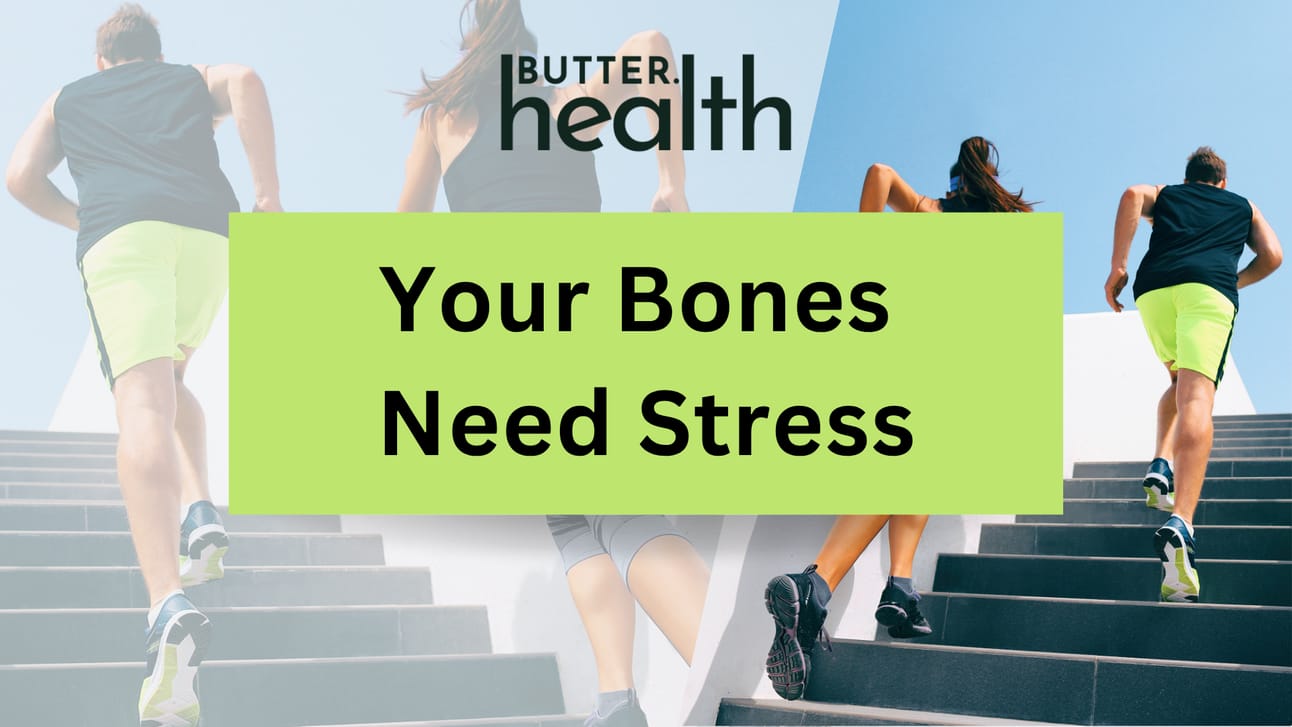- Butter Health
- Posts
- Your Bones Need Stress
Your Bones Need Stress
Are you giving your bones the stress they need to stay strong?

Just like faith is the foundation of a believer’s life, your bones are the foundation of your physical body. Without strong bones, your body cannot function at its fullest potential. Let’s dive into the science behind why you need to be actively loading your bones and how to do it.
Why Your Bones Need Stress 💥
Your bones are living tissue, constantly being broken down and rebuilt. This process, known as bone remodeling, involves two main types of cells:
Osteoclasts: These are the cells that break down bone tissue.
Osteoblasts: These are the cells that rebuild bone tissue.
For bones to remain strong, osteoblasts need a reason to work. If bones aren’t subjected to stress, osteoblasts won’t be triggered to rebuild them. This is where weight-bearing exercises come in—they provide the stress your bones need to stay strong.
The Science Behind Bone Health 🦴
Without stress, bones will lose density over time, a condition called osteopenia, which can progress to osteoporosis if left unchecked. This means your bones become fragile and more prone to fractures.
Bone remodeling depends on the mechanical forces placed on them. When you engage in weight-bearing or resistance exercises, the bones respond by rebuilding themselves stronger. Essentially, stress (from weight or resistance) stimulates osteoblasts to lay down new bone tissue, which increases bone density.
You Can’t Have Good Bone Health Without Movement 🛑
Just like faith requires action to grow, bone health requires movement to thrive. Sitting idle and avoiding weight-bearing exercises means you're not providing your bones with the mechanical stress they need. Without it, the bones lose mass, strength, and density. It's simple: If you don’t load your bones, they’ll become weaker.
How to Strengthen Your Bones: Practical Tips 💪
So, what can you do to ensure your bones stay strong? Here are science-backed, practical strategies:
1. Lift Weights (The Best Option for Bone Health) 🏋️♂️
Resistance training, whether with free weights, machines, or resistance bands, is one of the best ways to load your bones. Exercises like squats, deadlifts, and lunges work multiple muscle groups and put a significant load on your bones. Research shows that weight training increases bone density, particularly in the spine, hips, and wrists—key areas vulnerable to fractures.
Tip: Start with a weight that’s challenging but not overwhelming. Gradually increase the load as your body gets stronger.
2. Bodyweight Exercises
If you don’t have access to weights, bodyweight exercises like squats, push-ups, and planks are effective for loading bones. Studies show that exercises that involve bearing your body weight, especially those with impact (like jumping), stimulate bone remodeling.
Tip: Perform compound movements (e.g., squats, lunges) that engage multiple joints and muscles to maximize the load on your bones.
3. Walking or Running with Resistance 🚶♀️
If you’re not into lifting weights, walking or running with resistance is a solid alternative. Walking with a weighted vest or carrying light dumbbells adds stress to the bones, especially in the lower body, helping maintain bone strength.
Tip: Gradually increase the weight or intensity to avoid injury and ensure consistent progress.
4. Pilates and Yoga 🧘♀️
While these might seem low-impact, Pilates and yoga still provide resistance through bodyweight and movements that engage the bones, particularly the spine and hips. Pilates, especially, focuses on core strength, flexibility, and muscle endurance, all of which support bone health.
Tip: Focus on poses and exercises that involve balancing or bearing weight on one leg or arm, such as Warrior poses or plank variations.
5. Jumping and Plyometrics ⛹️♂️
High-impact activities, like jumping rope or plyometric exercises (e.g., box jumps, jump squats), are excellent for stimulating bone density. This type of exercise places an impact force on your bones, which encourages remodeling. Research has shown that high-impact loading, even for short periods, can improve bone density.
Tip: If you’re new to high-impact exercise, start slow to avoid injury and build up intensity over time.
6. Climbing Stairs 🏃♀️
This simple exercise is often overlooked, but it provides significant benefits for bone health. Climbing stairs puts weight on your leg bones, particularly the femur and tibia, stimulating bone density.
Tip: Try to add a few flights of stairs to your routine a couple of times a week.
Key Takeaways 🔑
Osteoclasts break down bone, but osteoblasts rebuild it. Your bones need consistent stress to stay strong.
Weight-bearing exercises are the most effective way to load your bones and increase bone density.
You don’t need fancy equipment; bodyweight exercises, walking with resistance, and even Pilates can help.
High-impact exercises, like jumping, provide a powerful stimulus for bone remodeling.
Final Thoughts
If you want to live with strength, vitality, and mobility, load your bones with purposeful, consistent movement. Just as you would never let your faith sit idle, don’t let your bones remain inactive. Start building a solid physical foundation today—your future self will thank you.
Need help taking the first step? Schedule a complimentary discovery call to see if working with a health coach is right for you.
Reply